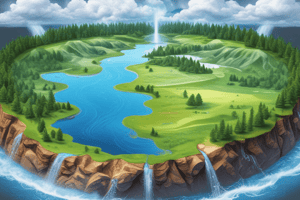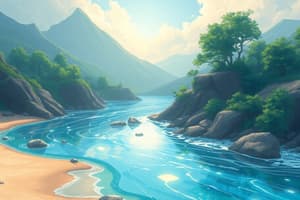Podcast
Questions and Answers
Most of Earth's water is suitable for drinking.
Most of Earth's water is suitable for drinking.
False (B)
The water cycle means that all the water on Earth is always new.
The water cycle means that all the water on Earth is always new.
False (B)
Snow and rain are essential for life because they provide water that plants and people need.
Snow and rain are essential for life because they provide water that plants and people need.
True (A)
Fresh water is primarily found in rivers and lakes, making it readily available.
Fresh water is primarily found in rivers and lakes, making it readily available.
Water vapor in the air can turn into clouds and rain.
Water vapor in the air can turn into clouds and rain.
What portion of the Earth's surface is covered by water, and why is most of it not drinkable?
What portion of the Earth's surface is covered by water, and why is most of it not drinkable?
In what forms can water in the atmosphere exist, and how do these forms relate to precipitation?
In what forms can water in the atmosphere exist, and how do these forms relate to precipitation?
What is the significance of the water cycle, and how does it affect the availability of water on Earth?
What is the significance of the water cycle, and how does it affect the availability of water on Earth?
Why is fresh water primarily found in ice or underground, and how does this affect its usability?
Why is fresh water primarily found in ice or underground, and how does this affect its usability?
How do seasonal changes affect rainfall levels in different regions, such as Jordan?
How do seasonal changes affect rainfall levels in different regions, such as Jordan?
Flashcards
Earth's water distribution
Earth's water distribution
Most of Earth's water is salt water in oceans and seas, and much of the freshwater is locked in ice or underground. Only a small portion is readily available in rivers and lakes.
Usable freshwater
Usable freshwater
The freshwater readily accessible for drinking and use in rivers, lakes, and some above ground sources.
Water cycle
Water cycle
A continuous process where water moves from the Earth's surface to the atmosphere and back again. Driven by the sun's heat.
Importance of water for life
Importance of water for life
Signup and view all the flashcards
Water quality
Water quality
Signup and view all the flashcards
Saltwater vs. Freshwater
Saltwater vs. Freshwater
Signup and view all the flashcards
Where is Most Freshwater Found?
Where is Most Freshwater Found?
Signup and view all the flashcards
What is the Water Cycle?
What is the Water Cycle?
Signup and view all the flashcards
Water's Importance for Life
Water's Importance for Life
Signup and view all the flashcards
Conserving Water
Conserving Water
Signup and view all the flashcards
Study Notes
Earth's Water Distribution
- Most of Earth (70%) is water, but much of it is saltwater in oceans and seas, making it undrinkable.
- Most freshwater is either ice or underground, making it hard to access readily.
- Only a small portion of water is in rivers and lakes, readily accessible for human use.
Water Availability
- Water exists in the atmosphere as well, forming clouds and precipitation (rain and snow).
- These forms of water are crucial for plant life and human consumption.
- The provided text emphasizes the importance of conserving water resources.
The Water Cycle
- Earth's water supply is ancient; it has always been present in various forms and locations.
- Water continuously moves through a cyclic process, the water cycle.
- Solar radiation heats water sources, causing some water to evaporate and rise into the atmosphere.
- As the air cools, the water vapor condenses into clouds.
- Clouds release water as rain or snow based on temperature.
- Precipitation falls on land, some running into rivers and eventually back to the sea, while others seep into the ground.
Studying That Suits You
Use AI to generate personalized quizzes and flashcards to suit your learning preferences.




